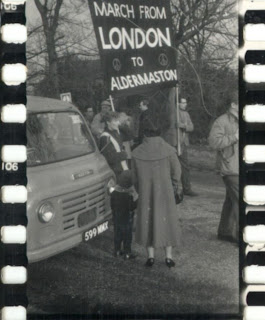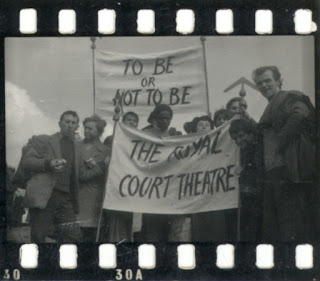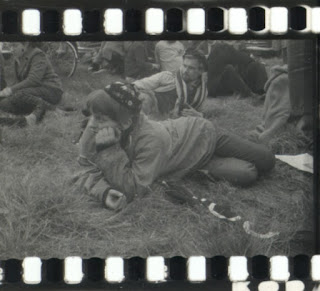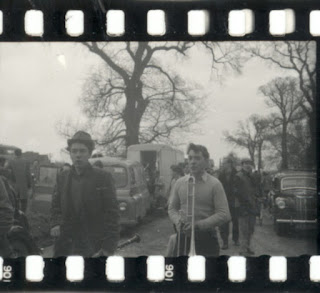LA/6/2/2/29/4(5) Image from the march to Aldermaston, Easter 1958
© Lindsay Anderson Collection, University of Stirling Archives
© Lindsay Anderson Collection, University of Stirling Archives
I'm having a short enforced break from cataloguing whilst my database (notice the possessive use here!) is being converted to become an online catalogue. Hopefully this will be ready within the next two weeks and I can share it all here. Today I can start back on cataloguing (phew!) but I thought I'd share some of alternative work I've been doing over the past few days before I get back to my files! Seeing as how discussing the numbering and reordering I've been doing may be slightly dull I thought I'd focus on the new sets of images I've uploaded to the University Archives Flickr site. I've scanned in five sets of photographs, or contact strips to be more precise and although the quality isn't all that great in a few of them - some fading, bright spots, tears etc. the content of the images is great and I think the distress on some of them just adds to the character.
The main subject of the images is the 1958 march from London to Aldermaston. This was a march organised over the Easter weekend 1958 by the Campaign for Nuclear Disarmament (CND). CND was formed a few months earlier in February 1958 and this was their first large organised protest. Several thousand people took part in the four day march which travelled from London to the Atomic Weapons Research Establishment at Aldermaston in Berkshire. There was a contingent of friends and supporters from the Royal Court Theatre who took part in this march and they can be seen, with their theatre inspired banners ('To be or not to be'), in the images below.
LA/6/2/2/30/2(6) Image from the march to Aldermaston, Easter 1958
© Lindsay Anderson Collection, University of Stirling Archives
© Lindsay Anderson Collection, University of Stirling Archives
LA/6/2/2/32/1(6) Image from the march to Aldermaston, Easter 1958
© Lindsay Anderson Collection, University of Stirling Archives
© Lindsay Anderson Collection, University of Stirling Archives
LA/6/2/2/30/3(2) Image from the march to Aldermaston, Easter 1958
© Lindsay Anderson Collection, University of Stirling Archives
© Lindsay Anderson Collection, University of Stirling Archives
Lindsay Anderson took part in this march and was also central to the creation of a film March to Aldermaston (1959). The film was made by a committee of volunteers entitled the 'Film and Television Committee for Nuclear Disarmament'. Along with Lindsay Anderson was Karel Reisz and a whole team of experienced film workers. This included lab technicians who worked for free to process the footage and Contemporary Films, who handled the distribution of the film. Although the film is credited to the entire committee it is widely acknowledged that Lindsay Anderson took over the film at the editing stage and shaped it into the film. The narration of the film is by Richard Burton, who also narrated Lindsay Anderson and Guy Brenton's Thursday's Children (1954). The commentary which Burton read was written by Christopher Logue (a poet and playwright and a friend of Anderson's). The film itself seems as relevant to me today as it was then and indeed this made the film even more powerful in my mind - the fact that nothing much has changed. Personally I find the support of nuclear weapons quite incomprehensible (of course, money and power are the main reasons but quite why these should outweigh the concern for human life is beyond me). Whatever your political views though I think this film would be very interesting to watch as a document of the 1950s. Like the films created by Anderson and others under the banner of Free Cinema this film documents the lives and concerns of ordinary working people.
The film is available as part of the boxset DVD on Free Cinema produced by the British Film Institute. There is more information about the film on BFI Screenonline. For more information about CND see their website.
I like that the images show the periods of rest and fun in between the marching, for example the photo below of a girl having a rest. There was musical accompaniment to the march, inlcuding folk music and jazz and there are a number of photos like the one second below which show the musicians taking part in the march.
LA/6/2/2/29/4(1) Image from the march to Aldermaston, Easter 1958
© Lindsay Anderson Collection, University of Stirling Archives
© Lindsay Anderson Collection, University of Stirling Archives
LA/6/2/2/29/3(4) Image from the march to Aldermaston, Easter 1958
© Lindsay Anderson Collection, University of Stirling Archives
© Lindsay Anderson Collection, University of Stirling Archives









